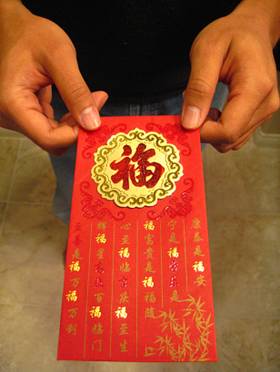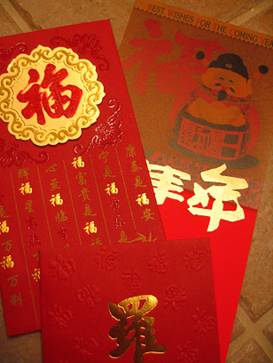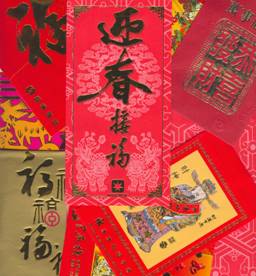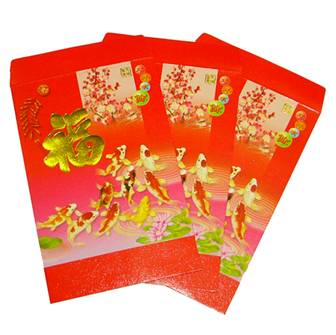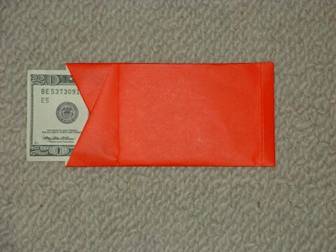 |
 |
||
|
source: http://en.wikipedia.org/wiki/Image:Laisee.jpg
|
|
Red EnvelopesAn old Chinese Tradition.by Branden Black, David Levine, Jessica Oh, and Alex Wei As traditions are passed from generation to generation, the original meanings and reasons behind the practice are often lost or obscured by new adapted forms. In other instances, the practice itself may change while the reasons for the event remain the same. The Chinese practice of giving money in red envelopes on the Lunar New Year is a prime example of something that has undergone such a change. The traditional red envelopes that hold the monetary gifts date back to the ancient tradition of celebrating the Lunar New Year in Chinese culture. The legends associated with the origins of the red envelopes vary, but most include a magical and evil entity that was defeated. Although most people agree that the red envelope tradition is centuries old and, there is some debate over whether money has always been a part of the tradition, or whether the money became a part of the tradition at a later stage. Michael Hanna, a writer of an advice centre regarding the etiquettes of the red envelope tradition, states that the red envelopes originated in the Sung Dynasty in China, when a young orphan defeated a huge demon terrorizing the village of Chain-Chieu. Although the greatest warriors of the time could not defeat this demon, the young orphan was able to kill the demon by using a magical saber. To show their gratitude, the elders of the village presented the orphan with a red envelope filled with money. Another popular legend states that the red color of the envelopes stems from when people used to paste red-paper couplets on their doors in order to scare away Nien, a ferocious beast that eats people on New Years Eve. In addition, a Taiwanese government site states that the custom of the red envelopes dates back to the Quing dynasty, rather than the Sung Dynasty. In their recollection of the red envelope tradition, the elders of a family traditionally gave the children one hundred coins weaved into the shape of a dragon. However, the hundred coins proved to be inconvenient to give out, and this tradition eventually evolved into the modern tradition of giving paper money in red envelopes. Although many people have theories, no one can give a definitive answer as to how the red envelope tradition started and then evolved into the practices that are used today. Although we don’t know how these traditions originated, we can observe the many different manifestations of the old tradition as they take place today. The red envelope money gifting is now a core component of the Lunar New Years celebration. The envelopes are usually handed out during the day of the Lunar New Year, and this is where the different traditions that currently take place differ. Although most of our interviewees generally agree that the red envelope tradition is usually associated with a family dinner that takes place during the evening of the Lunar New Year, the individual customs associated with the giving and the receiving of the envelopes differ. One interviewee stated that the children in his family must first say a Chinese phrase that roughly translates into, “Happy New Year, bring the red envelope.” The interviewee stated that in his family’s traditions, the envelope would be given after the phrase had been said, and the receiver must “receive with both hands and do a little head bow. Very slightly but noticeable. And end it with a hug.” The use of this phrase is a fairly prevalent practice throughout many households. Although to a western observer, the phrase may seem quite brash and materialistic, several of our interviewees have echoed the sentiment that, “It doesn’t sound so bad…in Chinese because it’s so traditional.” This phrase has become one of the common manners used by the red envelope recipients to initiate the ceremony. In other families, the tradition of giving and receiving the envelopes had evolved into a must less formalized tradition. When asked about customs associated with the giving and receiving of the envelopes, one interviewee stated that, “it’s usually like a family dinner and they walk in and you say hi to them and they give you the envelope and you say thank you.” This interviewee also stated that he wasn’t sure if his family members usually received the envelopes with both hands. Once the envelope is received, it is customary to wait to open the envelopes until the giver is out of sight. Opening the envelope in the presence of the giver is considered rude and reflects poorly on the manners of the child and his parents. An interviewee referred to this custom and stated, “You can’t open it [the envelope] in front of the giver…you know that’s just based off of Chinese tradition. It’s like that saying, ‘don’t look a gift horse in the mouth.’ I do it as soon as everybody leaves…or if I have privacy, like in my room.” Although the majority of the envelopes are given on the Lunar New Year, this tradition does not always occur on the actual day of the Lunar New Year. Because there are often obstacles to seeing all friends, family members, and acquaintances on the one day, people usually begin giving the red envelopes in the weeks and days surrounding the Lunar New Year. There have also been instances of red envelopes being mailed by a relative living out of state. In addition, many families use the red envelopes during other occasions, such as holidays, birthdays, and weddings. Unlike in the United States where people often bring goods as wedding gifts, in Taiwan and China it is much more common to give gifts of cash using the red envelopes. The money itself can usually be spent as the receiver sees fit and there are usually not any restrictions placed upon it. As one interviewee put it, “Its your money. Once its given to you, its yours.” However, it was interesting to note that most of the interviewees kept the money until he had informed his parents of the specifics of the envelopes, such as who gave what amount, before actually taking the money freely and spending it. In addition, one of our interviewees stated that he usually splits the money with his parents, and only takes a share of it. Although the red envelopes are usually thrown away after the money has been taken out, some people keep various envelopes for its sentimental value, and others even reuse the envelopes. The most widely used contemporary function of the red envelopes is to give cash as a gift. The cash is placed within the envelope and then given to the recipient. The most common time of year when this occurs is during the Lunar New Year that is celebrated by Asian cultures. During this time adults, traditionally defined as a married people, give out the red envelopes to children and the young adults who have yet to marry. The envelopes are usually given out to relatives and close friends of the family. When giving out the envelopes, the value of the money inside the envelope is decided on by the giver and is usually a reflection of the relationship to the receiver. Thus, if the giver and receiver have a close relationship, such as parent and child, then the receiver will typically get a higher denomination gift than if they had received the envelope from a distant relative. The denominations given can get very substantial in size, from hundreds of dollars, for those very close relations and they can also range down to as little as one dollar given as a symbolic gesture. The traditional practice of the red envelope is currently being carried out by many different Asian cultures across the world. As the practice continues to change to meet the needs of modern day culture, the purposes and original meanings of the tradition, as well as the true origins, seem to have gotten lost along the way. From the recipient’s point of view, red envelopes are now associated with the monetary value of the gift much more than the original cultural purposes of the practice. “Most of us only think about how much money we will get in the red envelope. We don’t really know why it’s important or the reason why we have to make an offering to our ancestors,” remarked one young beneficiary of this practice. The red envelope aspect of the New Years celebration has been able to flourish in southern Californian Asian communities whereas many of the older religious aspects of the celebration have died out. Old traditions can become hard to carry on in the face of a changing society. One interviewee was asked, “Why are the Chinese New Year Envelopes the only thing that lasts when the other Chinese Traditions die out?” He replied, “ ‘cause it’s the easiest to do…you go to like a temple to pray or whatever but uh…you can’t do that so easily in the United States as you could in China or Taiwan.” The red envelope tradition is widely practiced in Southern California largely because the practice is easier to carry out in than religious practices. The red envelopes are readily accessible with the aid of commercialization through corporations that mass produce these envelopes. The original meaning of the envelopes may have been watered down or lost to our generation of participants, but the new practice is still being carried on in its new forms. As well as the superstitions that influence manner in which the gift is given, there are beliefs that induce and reinforce the gift giving practices. The red color of the envelopes has traditional symbolism attached in Feng Shui, the Chinese design system which connects the physical properties to spiritual aspects of life. The color red symbolizes, “a rising ‘chi’, heat, reputation, increasing energy, expansion, living color, auspicious color, healthy cells and blood, life energy, and vitality. One manifestation using this symbolism is the practice of placing two coins in the red envelope and putting it over a doorway. The envelope is seen as harnessing all of the positive aspects of the color and thus becomes a symbol for prosperity. In the sense of heat and increasing energy, the red envelope is said to ‘ignite’ any wishes to fruition when written on notes placed inside the envelope. Feng Shui practices also state that the red envelope will cleanse the money of all negativity and the gift should thus make the receiver happy. The red envelope money, sometimes referred to as "Age suppressing money," (Ya Shui Chien) acts as an incentive for elders to give to the younger generation. One source says the money in the envelope is kind of bribe that buys a year of life for the elder from the youthful receiver. Another source, contradictorily, gives the meaning of the red envelope to ensure children’s health and strength by putting any past illnesses behind them. This type of practice has been labeled "age extension money." Although the images on the front of the envelopes vary drastically, they all are said to garner blessings and good wishes. Many envelopes include images of animals such as dragons and bulls, while others have a family name or the name of a corporation or business imprinted on the front. In addition, more modern manifestations of the envelopes include cute cartoon depictions of various characters and animals. The actual bills contained inside are usually crisp, brand new bills. One source claims old worn bills carry with them the bad luck of the past year. These examples are manifestations of the symbolic energy attached to the color red; they bestow energy into someone involved with the red envelopes The recipient gets good luck not only from the encapsulated money but also from the passing on of the culture itself. Most of the interviewees and online correspondents said that they will continue the practice of the red envelope to carry on their culture. It’s a tangible, material, token of the Chinese heritage and is thus highly important. The author of Vigils: From the Office of the Dead wryly points out that red envelopes contained money and a culture not bills. Individuals may claim that the monetary aspect is the most important component of this practice, but it can be argued that the more important aspect to the culture is that the preservation of a cultural heritage. An interviewee states that, “as a tradition for my kids to follow later on, it’s[red envelope tradition] kind of important. Even if they don’t understand the meaning behind it, it’s kind of important for them to be able to identify it as a Chinese tradition even if they don’t know the meaning behind it.”
|
 |
Dept. of Anthropology
University of California, Irvine
Irvine, CA 92697-5100
email wmmaurer at uci dot edu
